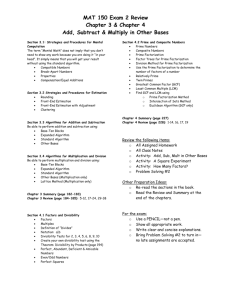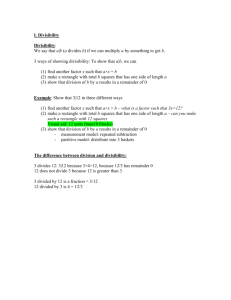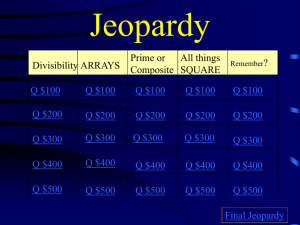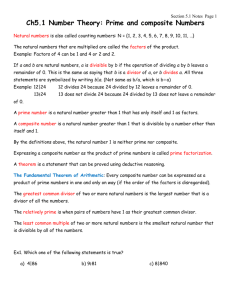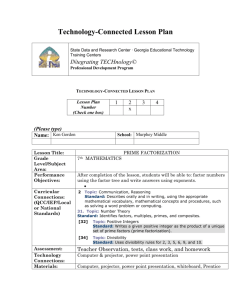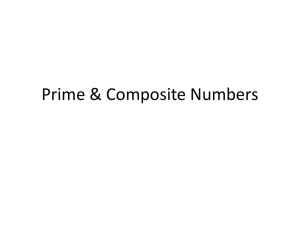Unit 1 Lesson Plan
advertisement
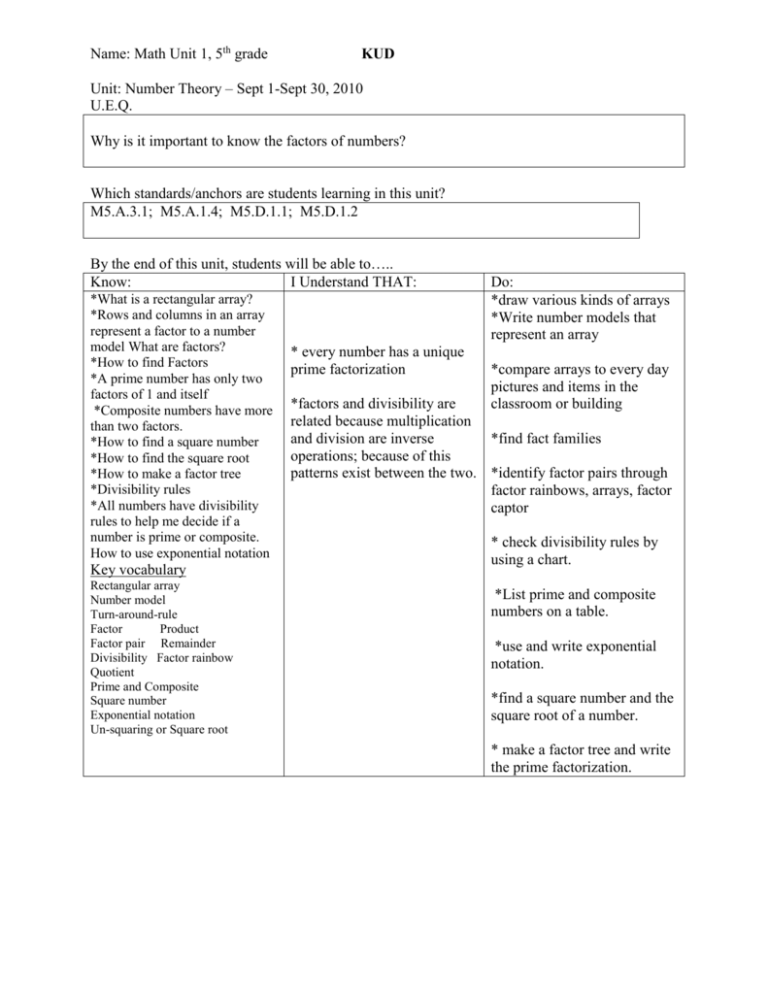
Name: Math Unit 1, 5th grade KUD Unit: Number Theory – Sept 1-Sept 30, 2010 U.E.Q. Why is it important to know the factors of numbers? Which standards/anchors are students learning in this unit? M5.A.3.1; M5.A.1.4; M5.D.1.1; M5.D.1.2 By the end of this unit, students will be able to….. Know: I Understand THAT: *What is a rectangular array? *Rows and columns in an array represent a factor to a number model What are factors? *How to find Factors *A prime number has only two factors of 1 and itself *Composite numbers have more than two factors. *How to find a square number *How to find the square root *How to make a factor tree *Divisibility rules *All numbers have divisibility rules to help me decide if a number is prime or composite. How to use exponential notation Key vocabulary Rectangular array Number model Turn-around-rule Factor Product Factor pair Remainder Divisibility Factor rainbow Quotient Prime and Composite Square number Exponential notation Un-squaring or Square root * every number has a unique prime factorization Do: *draw various kinds of arrays *Write number models that represent an array *compare arrays to every day pictures and items in the classroom or building *factors and divisibility are related because multiplication and division are inverse *find fact families operations; because of this patterns exist between the two. *identify factor pairs through factor rainbows, arrays, factor captor * check divisibility rules by using a chart. *List prime and composite numbers on a table. *use and write exponential notation. *find a square number and the square root of a number. * make a factor tree and write the prime factorization. Lesson 1 – Arrays and factor pairs 1.1-1.4 Unit Essential Question: Why is it important to know the factors of numbers? Lesson Essential Question: How do I use arrays to represent factor pairs? Answer: The first factor in a number model represents the row and the 2nd number represents the columns. The total number of dots equals the product. What do students need to learn to be able to answer the Essential Question? Assessment Prompt #1: How does a number model represent an array? Assessment Prompt #2: What is a factor pair and show an example? Assessment Prompt #3: How does the memorization of multiplication facts help me to understand factor pairs? Activating Strategy: Use Geo-boards for students to form rectangular arrays -----------------------------------------------------------------------------------------------------------Key vocabulary to preview: Product, Rectangular array, Number model, , Turn-aroundrule, Factor, Factor pair, Divisible by, Product, Teaching Strategies: active instruction, pair/share, journal work Graphic Organizer: Vocabulary Chart -----------------------------------------------------------------------------------------------------------Instruction: Begin the class by handing out geo-boards and rubber bands and ask the students to make rectangles. Have them write down the number of rows and columns for each array they make. Explain number model. AP#1 using think/pair/share. AP #1: How does a number model represent an array? Continue using your teacher’s guide and student journal pages 5-8. for lesson 1.2 Begin with lesson 1.3 math message and then ask AP#2. AP #2: What is a factor pair and show an example? Then continue with Lesson 1.3 in teacher’s guide and student journal pages 9-11. Follow journal page12 and SRB page 306 for Lesson 1.4. When finished with lesson 1.4 ask AP#3. AP #3: How does the memorization of multiplication facts help me to understand factor pairs? Summarizing Strategy: Number 1 answers the lesson essential question and number 2 writes it down and is prepared to share. Lesson 2 – Prime and Composite 1.5-1.6 Unit Essential Question: Why is it important to know the factors of numbers? Lesson Essential Question: How do I use divisibility rules to determine prime or composite numbers? Answer: A prime number has only 2 factors (1 and itself) –I check to see how many factors a number has using divisibility rules. What do students need to learn to be able to answer the Essential Question? Assessment Prompt #1:How do I know that a number is divisible? Assessment Prompt #2: How can I use a factor rainbow to help me find all factor pairs? Assessment Prompt #3: How are divisibility rules helpful? Activating Strategy: Array Graphing -----------------------------------------------------------------------------------------------------------Key vocabulary to preview: Factor rainbow, Divisible by, Quotient, Divisibility rule, Composite, prime Teaching Strategies: active instruction, pair/share, journal work Graphic Organizer: Vocabulary Chart -----------------------------------------------------------------------------------------------------------Instruction: Begin the class by doing math message for 1.5 and then ask . Hand out graph paper. Group students into pairs and assign two numbers 1-20 to each pair. Have them cut out their array and paste it next to their number on chart paper. AP#1 using think/ink/share. AP #1: Ask pairs to write patterns they see in the arrays? Clarify prime and composite numbers. Continue using your teacher’s guide and student journal pages 13-15. for lesson 1.5 Begin with lesson 1.6 math message and then ask AP#2. AP #2: How can I use a factor rainbow to help me find all factor pairs? Then continue with Lesson 1.6 in teacher’s guide and student journal pages16-19. At the end of the lesson ask AP#3 using think/pair/share. AP #3: How are divisibility rules helpful? Summarizing Strategy: Have student 2 ink and student 1 tell the two most important things they need to remember about prime and composites Lesson 3 Square Numbers and Square Root -1.7-1.8 Unit Essential Question: Why is it important to know the factors of numbers? Lesson Essential Question: How are square numbers and square roots related? Answer: A square number is a number times itself; a square root is a number that has 2 equal factors What do students need to learn to be able to answer the Essential Question? Assessment Prompt #1: What shape do all of the arrays in the math message create and why? Assessment Prompt #2: What does the exponent represent? Assessment Prompt #3: How are divisibility rules helpful? Activating Strategy: Math Message -----------------------------------------------------------------------------------------------------------Key vocabulary to preview: Square array, Square number, Exponential notation, Exponent, Unsquaring, Square root Teaching Strategies: active instruction, pair/share, journal work Graphic Organizer: Vocabulary Chart -----------------------------------------------------------------------------------------------------------Instruction: Begin the class by doing math message for 1.7 and then ask AP#1 using think/pair/share. AP #1: What shape do all of the arrays in the math message create and why? Continue using your teacher’s guide and student journal pages 20-22. for lesson 1.7 Begin with lesson 1.8 math message and then ask AP#2. AP #2: What does the exponent represent? Then continue with Lesson 1.8 in teacher’s guide and student journal pages 23-24. At the end of the lesson ask AP#3 using think/pair/share. AP #3: How do I unsquare a number? Summarizing Strategy: Each students writes a “Dear Mom, in Math class today I….” letter Lesson 4 – Factor Trees 1.9 Unit Essential Question: Why is it important to know the factors of numbers? Lesson Essential Question: How do I find prime factorization using factor trees? Answer: Use factor pairs to divide the product until there are only prime numbers left What do students need to learn to be able to answer the Essential Question? Assessment Prompt #1: Why do you think the number 1 is not used in a factor string? Assessment Prompt #2: How do divisibility rules help me to create a factor tree? Activating Strategy: Math Message -----------------------------------------------------------------------------------------------------------Key vocabulary to preview: Factor string, Factor tree, Prime factorization Teaching Strategies: active instruction, pair/share, journal work Graphic Organizer: Vocabulary Chart -----------------------------------------------------------------------------------------------------------Instruction: Begin the class by doing math message for 1.9 and then discuss using think/pair/share. Continue using your teacher’s guide and student journal pages 25-27. for lesson 1.9 AP #1 – Why do you think the number 1 is not used in a factor string? AP #2: How do divisibility rules help me to create a factor tree? Have the students review their graphic organizer and make sure they complete them. Summarizing Strategy: All students write an acrostic for the word FACTORS to summarize what they know about them All students answer the UEQ on the back side of their learning map. UEQ answer: factors and divisibility are related because multiplication and division are inverse operations; because of this, patterns exist between the two. Word/Vocabulary Product Factor Factor pair Rectangular Array Number Model Turn Around Rule Divisible Example/Picture Explain Word/Vocabulary Example/Picture Explain Product 2*2=4 The answer when numbers are multiplied together Factor 2 * 2=4 The numbers that are being multiplied 5*2=10 Two numbers (a pair) when multiplied equal a product. Factor pair Rectangular Array Number Model :::::: 2 * 6 = 12 Turn Around Rule 1*3=3 3*1=3 Divisible 8 / 2= 4 - An arrangement of objects in rows and columns in a rectangle. - A number sentence that models an array or number story. A rule for solving mult. Or addition problems when the factors or addends can be turned around and still get the same product or sum. When a larger number can be divided by a smaller number and there is no remainder Topic: Answer LEQ Concept #1 Vocabulary Answer LEQ Concept #2 Vocabulary Answer LEQ Concept #3 Unit Essential Question: Vocabulary Answer LEQ Concept #4 Vocabulary Answer LEQ Concept #5 Vocabulary Answer LEQ Concept #6 UEQ Answer: Vocabulary Topic: all numbers are related Concept #2: Prime and Composite Unit Essential Question: Why is it important to know the factors of numbers? Concept #1: Arrays and Factor Pairs LEQ: How do I use divisibility rules to LEQ: What is the difference between square determine prime or composite numbers? numbers and square roots? Concept #3: Square Numbers and Square Root LEQ: How do I use arrays to represent factors pairs? Vocabulary: Square array Square number Exponential notation Exponent Unsquaring Square root Answer: A square number is a number that has two factors that are exactly the same; a square root is a number one of the 2 equal factors of a square number. Answer: A prime number has only 2 factors (1 and itself) I check to see how many factors a number has using divisibility rules. Vocabulary: Factor rainbow Divisible by Quotient Divisibility rule Composite prime 1 is neither prime or composite Answer: The first factor in a number model represents the row and the 2nd number of dots represents the columns and the total number of dots equals the product. Vocabulary: Product Rectangular array Number model Turn-around-rule Factor Factor pair Divisible Product Answer: Use factor pairs to divide the product until there are only prime numbers left LEQ: How do I find prime factorization using factor trees? Concept #4: Factor String Vocabulary Answer LEQ Concept #5 Vocabulary Answer LEQ Concept #6 UEQ Answer: multiplication and division are inverse operations; because of this patterns exist between the two, therefore numbers are related Vocabulary: Factor string Factor tree Prime factorization Topic: all numbers are related LEQ: How do I use arrays to represent factors pairs? Concept #1: Arrays and Factor Pairs Answer: Answer: LEQ: How do I use divisibility rules to LEQ: What is the difference between square determine prime or composite numbers? numbers and square roots? Concept #2: Prime and Composite Vocabulary: Square array Square number Exponential notation Exponent Unsquaring Square root Unit Essential Question: Why is it important to know the factors of numbers? Answer: Vocabulary: Factor rainbow Divisible by Quotient Divisibility rule Composite prime Concept #3: Square Numbers and Square Root Vocabulary: Product Rectangular array Number model Turn-around-rule Factor Factor pair Divisible Product UEQ Answer: Concept #4: Factor String LEQ: How do I find prime factorization using factor trees? Answer: Vocabulary: Factor string Factor tree Prime factorization Extra Notes Word/Vocabulary Product Example/Picture Explain The answer when numbers are multiplied together Factor The numbers that are being multiplied Factor pair Two numbers (a pair) when multiplied equal a product. Rectangular Array Number Model Turn Around Rule Divisible - An arrangement of objects in rows and columns in a rectangle. - A number sentence that models an array or number story. A rule for solving mult. Or addition problems when the factors or addends can be turned around and still get the same product or sum. When a larger number can be divided by a smaller number and there is no remainder

